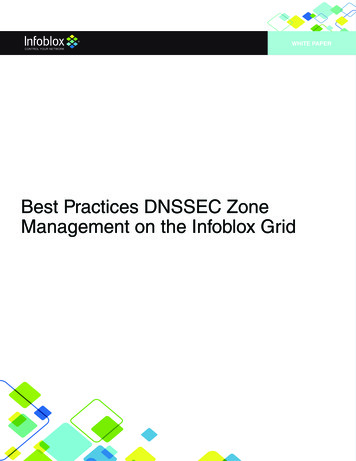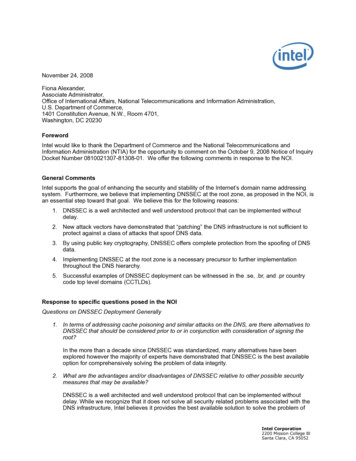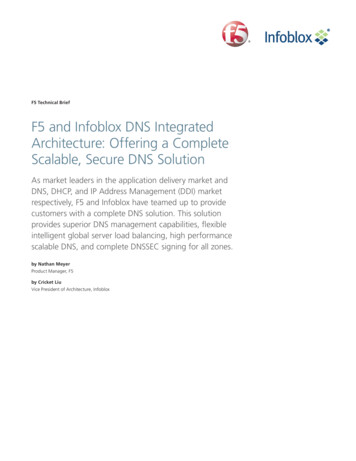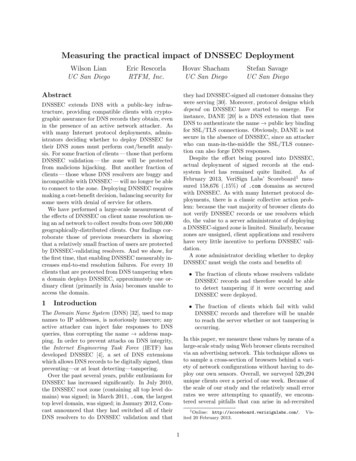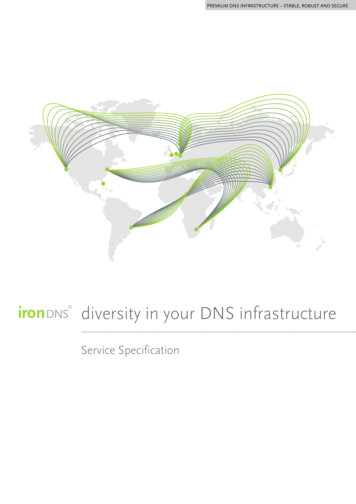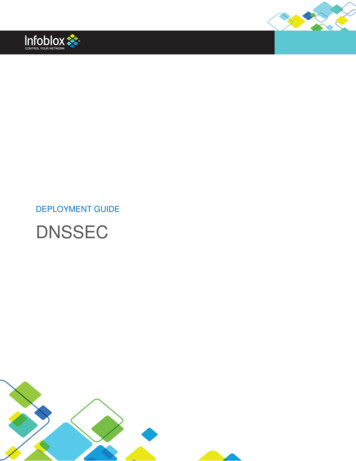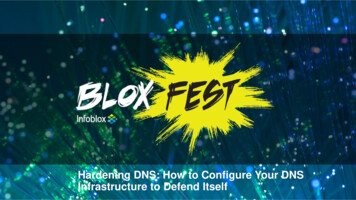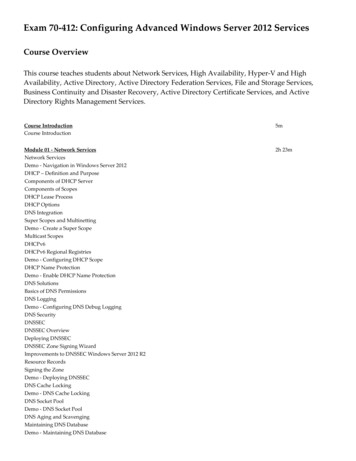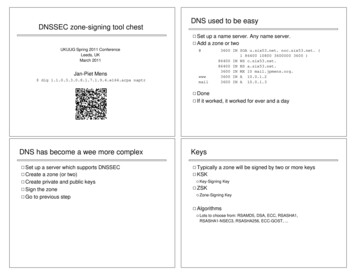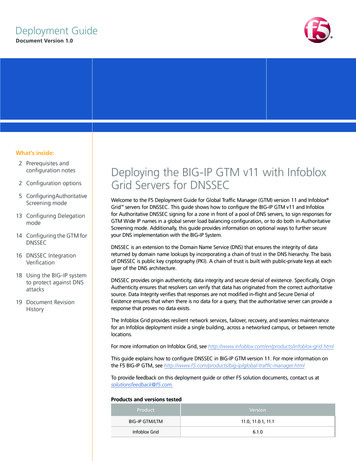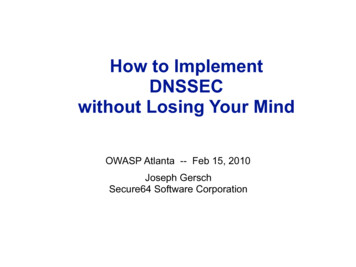
Transcription
How to ImplementDNSSECwithout Losing Your MindOWASP Atlanta -- Feb 15, 2010Joseph GerschSecure64 Software Corporation
AgendaWhy is DNSSEC vitally important?How does DNSSEC work?What are my options for implementing it?Now what do I do?2
Why isDNSSECvitallyimportant?
DNS Infrastructure ChallengesWeb 2.0Hidden ComputingMore DevicesPerformance DemandsDNSSecurity DemandsBotnetsMalwareCache PoisoningConventional DNS solutionscan’t keep up4with performance and security demands
Most Concerning ThreatsDNS Cache Poisoning30%23%15%8%0%Bots/BotnetsBGP Route HijackingLink FloodingIdentify Theft1DNS Cache PoisoningDNS, VOIP, other servicesSystems CompromiseWormsSource: Arbor NetworksBotnets, DNS and5 cache poisoningamong the top concerns
You think your IT is protected, but. Firewalls, IPS, IDS.6
But users might not even get to you!real site:“my firewalls are up, butwhere did everyone go?DNS Query:“where is mybank.com”?poisoned DNS Server:“It’s at 1.2.3.4”, honest!!!”7fake site
Lots of queries, lots of wrong answersTruth. or Consequences8
It’s been a year since Blackhat. Is the Kaminsky attack still relevant?When you own the DNS,you own EVERYTHING!9
Yes, DNS Poisoning Really HappensAttacks are real 1-3% of monitored unpatchednameservers have had a poisoningevent detected Confirmed phishing attacks have beenfound Brazilian Bank poisoned April 23, 2009Patches are short term fix Patched systems have beencompromised in 10 hours Use of botnets can greatly reduce timeto compromiseDNSSEC is permanent solutionSource: IO Active, Dagon et. al.10
What’s the solution? The DNS patch raisesthe bar, but DNS canstill be breached How do you stop the storm? DNSSEC is the longterm permanent solution11
DNSSEC does more than defend Sure It reduces risk– buts it’s not just about the Kaminsky attack It adds value and enables new killer apps––––AUTHENTICATION on the net!!!email, SSL, VOIP can all be made better.Authentication for doctors, privacy issues, etc.everything that RSA likes to talk about What can you do with an authenticated internet?12
How doesDNSSECwork?
DNS attack vectorsZone files andDatabasesMaster server412Dynamic DNSupdates34Slave servers1.2.3.4.5.Cachingserver5Resolving clientTampering with zone data / Domain hijackingForged DNS updatesMaster impersonating / Unauthorized zone transfersCache poisoning / DoSMan in the middle / Corrupted DNS resolution path14
What Is DNSSEC?What does it do? Validates the source of theDNS responsewww.robbers-r-us.com Ensures the response hasnot been altered in transit Authenticates replies of iveServerReBogusp sonseHow does it work? Adds digital signatures toDNS responses Uses chains of trust tovalidate responses Identifies bogus responsesWith DNSSEC, we are certain that aresponse is correct
Well, if DNSSEC fixes the problem. Why hasn’t it been more widely deployed? Who has already deployed it? Should I deploy it?16
DNSSEC Deployment ChallengesComplexitySecurityOperational MechanicsDisaster RecoveryScalabilityAuditabilityEarly adopters invest 4-6 man-months todeploy, ½ full time person to maintain
The Process Is ComplexSign all zones Generate public/private key pairs (one pair per zone, ideally) Insert keys into zone files Sign the zonesRe-sign the zones Retrieve keys from secure storage Re-sign the zonesOnceWeeklyor wheneverdata changesRoll the ZSKs for each zone Generate new key pairs per zone Add the new keys to the zone Re-sign the zone using the old key Wait for one TTL period Re-sign the zone using the new key Wait for one TTL period Remove the old ZSK from the zone file Re-sign the zoneMonthlyRoll the KSKs for each zone Generate new key pairs (ideally one per zone) Sign the DNSKEY RRset with both KSKs Wait one TTL period Update the DS record at the parent and verify Remove the old KSK from the zone and re-signAnnuallyGood process disciplinerequires tools,procedures and training
Manual DNSSEC Deployment StepsGenerate keys and Insertthem into zone filesSign and publish the zonesgenerate NSECsgenerate RRSIGsDo process over and overagain when data changes orwhen keys need to bereplaced Labor and training intensiveOK for small deployments,but begs for automation19
The Human Element:What could possibly go wrong Wrong keysExpired KeysStolen KeysTraining/TurnoverSolution doesn’t scaleGood Until 21/10/0920
Keys Must Be Kept SecureWhy? Digital signatures guarantee authenticity, but. Signatures can be forged if attacker gains access to private key Someone can hijack your domain and guarantee it!How to protect keys? Keep them offline– Must ensure only authorized personnel can access– Labor intensive– Doesn’t work well for ZSKs in dynamic environments Keep them online– Must protect them from unauthorized access– OS hardening insufficient to guarantee security– FIPS 140-2 level 2-4 certified crypto modules work best, but can requirecustom hardware integration21
Nevertheless, DNSSEC is deployed In Europe–––––.se --- Sweden is the poster child.cz.uk and other ccTLD’s in the works.nl has signed its ENUM zonemany individual organizationsandorg Around the globe:!gniw– .org is signed; .com and .net will be signed; root to be signed– .gov (USA) is signed– check out secspider.cs.ucla.edu 3929 production zones signed 16.000 zones with DNSSEC data22
And DNSSEC technology is on the rise make it easy23
What are myoptions forimplementingDNSSEC?
Solution MatrixS64DNSSignerHighIPAMSystemsAutomationLow2st GenManualTools1st GenManualToolsLowHighSecure Key ManagementFor info on this matrix, download “Choosing aDNSSEC Solution: Beware Dark Zones ingdnssec-solution.pdf
Do-It-Yourself Methods BIND “do-it-yourself” programs– DNSSEC-Keygen & DNSSEC-Signzone 1st & 2nd generation tools/scripts– www.nlnetlabs.nl : LDNS library has signer tool, etc.– www.dnssec-tools.org : dozens of scripts, signer, key roller– www.opendnssec.org : not yet formally released, technology preview 2nd generation tool has automation and a XML format forspecifying DNSSEC policies26
Full Automation Handles all the details1.Key Generation for huge numbersof keyspre-generate “spare keys”2.Bulk Signing and Re-signing cantake lots of timefast crypto3.Dynamic Updatesincremental signing4.Disaster PlanningAutomatic & Secure Backup ofMetadata5.Chain-of-Trust Coordinationautomated key rolloverBut be careful: some appliances are only“DNSSEC-compliant”, not automated
Automation: Secure64 DNS Signer Simple DeploymentAutomated key management,rollover, signing, re-signing Secure Key RepositoryMalware-immune OSFIPS 140-2 compliant (in-review) ScalableHigh performance signingIncremental zone signingSecure64 DNS Signer makes it easy to deployDNSSEC correctly and securely28
Simple to Configure1-line automationSERVER:# Default signing policyDnssec-automate: ONDnssec-ksk: 1024 RSASHA1Dnssec-ksk-rollover: 0 2 1 2,8 *Dnssec-ksk-siglife: 7DDnssec-zsk: 2048 RSASHA1Dnssec:zsk-rollover: 0 1 1 * *Dnssec-zsk-siglife: 7DDnssec-nsec-type: nsec3Dnssec-nsec-settings: OPT-OUT 12 aabbccddOptional parametersto override defaultsCan be applied system-wideor zone by zoneZONE:Name: myzone.File: myzonefileDnssec-nsec-type: nsec Configuration fileDNSSEC can be deployed in days, not months29
Compatible With Current den Master,Etc.)UnsignedZoneDataSignedZoneDataSecure64 DNSSlaveBINDSlaveNSDSlaveJust plug it into your existing DNS provisioning system30
Now whatdo I do?
Develop a plan to deploy DNSSEC Consider your situation:– Do I do this myself, or have my ISP do it for me? Consider your Objectives & Alternatives:– do I have the skills, enough training, the process discipline?– are my zones small and relatively static?– can I keep my keys off-line?»consider tools & scripts– does my DNS data change often? are my keys safe?– do I have staff turn-over?»consider automation appliance32
Full Planning: Design For Scalability Can you keep up with dynamic update loads?– Peak DHCP load may require lots of signing horsepower Do you have lots of zones to sign?– Some zones may be changing all the time– Different zones roll keys on different schedules Do you have a Service Level Agreement tomeet?– DNS update intervals may be guaranteed33
Full Planning: Plan for Disaster Back up the data whenever anything changes– Keys can change, but also – Zone signing state can change (zones may be in theprocess of a key rollover)– Must back up all information required to recover Protect the keys!– Private keys should not be in the clear in the backup Have a failover signing system– Backup signer or active/active configuration– Monitor active signer to detect outage Document backup/restore processes– Personnel can change– Don’t “lose the recipe”If DNSSEC signatures expire,your entire domain goes dark
Consider your staff Your administrators already have more than enough to do35
But above all: Do it -- deploy DNSSEC and protect your users but don’t drive your administrators crazy,consider automation appliances and tools36
Thank You!For More Information Secure64 web site: www.secure64.com Search YouTube for “Secure64” to view someuseful DNSSEC tutorials Sign up for access to an online signing engine totry it out with your own data37
DNS attack vectors Dynamic DNS updates Zone files and Databases Slave servers Master server Caching server Resolving client 2 1 3 4 4 5 1. Tampering with zone data / Domain hijacking 2. Forged DNS updates 3. Master impersonating / Unauthorized zone transfers 4. Cache poisoning / DoS 5. Man in the middle / Corrupted DNS resolution path 14
